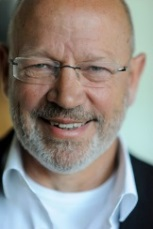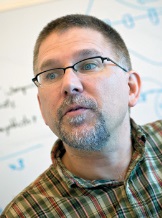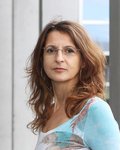Keynote Lectures
 Alexander Borst
Alexander Borst
Max Planck Institute of Neurobiology, Martinsried, Germany
How do Neurons Compute the Direction of Motion?
Detecting the direction of image motion is important for visual navigation as well as predator, prey and mate detection, and thus essential for the survival of all animals that have eyes. However, the direction of motion is not explicitly represented at the level of the photoreceptors: it rather needs to be computed by subsequent neural circuits, involving a comparison of the signals from neighboring photoreceptors over time. The exact nature of this process represents a classic example of neural computation and has been a longstanding question in the field. Only recently, much progress has been made in the fruit fly Drosophila by genetically targeting individual neuron types to block, activate or record from them. Our results obtained this way indicate that the local direction of motion is computed in two parallel ON and OFF pathways. Within each pathway, a retinotopic array of four direction-selective T4 (ON) and T5 (OFF) cells represents the four Cartesian components of local motion vectors. Since none of their presynaptic neurons turned out to be directionally selective, direction selectivity first emerges within T4 and T5 cells. Our present research focuses on the cellular and biophysical mechanisms by which this important visual cue is computed in these neurons.
 Robert Gentleman
Robert Gentleman
23andMe, San Francisco, USA
Using Genetic Data for Drug Discovery
Despite many advances in therapeutic discovery there is still a large amount of unmet medical need. Using genetic associations as a tool for drug discovery provides new candidates for therapeutic intervention. In this talk I will outline some of the challenges and opportunities for using genetics and bioinformatics to aid in the drug discovery process.
 Núria López-Bigas
Núria López-Bigas
Institute for Research in Biomedicine (IRB Barcelona), Barcelona, Spain
Coding and non-coding cancer mutations
Somatic mutations are the driving force of cancer genome evolution. The rate of somatic mutations appears to be greatly variable across the genome due to variations in chromatin organization, DNA accessibility and replication timing. However, other variables that may influence the mutation rate locally are unknown. I will discuss recent findings from our lab on how DNA-binding proteins and differences in exons and introns influence mutation rate. These finding have important implications for our understanding of mutational and DNA repair processes and in the identification of cancer driver mutations. Given the evolutionary principles of cancer, one effective way to identify genomic elements involved in cancer is by tracing the signals left by the positive selection of driver mutations across tumours. We analyze thousands of tumor genomes to identify driver mutations in coding and non-coding regions of the genome.
 Leonid Mirny
Leonid Mirny
MIT, Cambridge (MA), USA
Genome in 3D: models of chromosome folding
How can proteins that are much smaller than chromosomes drive chromosome compaction, segregation or control functional enhancer-promoter interactions at much large scales?
We develop a top-down approach to biophysical modeling of chromosomes: Starting with a minimal set of biologically motivated interactions and processes we build dynamic polymer models of chromosome organization that can reproduce major features observed in Hi-C experiments. Our works suggest that active processes of loop extrusion can be a universal mechanism responsible for formation of domains in interphase [1], and chromosome compaction and segregation in metaphase [2].
Our recent results [3,4] show that cohesin plays a central role in the loop extrusion process, while CTCF modulates progression of loop extrusion. Loss of these factors leads to predictably different changes in Hi-C maps and the loss of chromosomal domains (TADs). We further demonstrate that spatial compartmentalization of the genome remains largely unaffected by cohesin and CTCF loss, demonstrating that compartmentalization is produced by an independent and yet to be understood mechanism.
References
- Fudenberg G, Imakaev M, Lu C, Goloborodko A, Abdennur N, Mirny LA. Formation of Chromosomal Domains by Loop Extrusion. Cell Rep. 2016 May 31;15(9):2038-49
- Goloborodko A, Imakaev MV, Marko JF, Mirny L. Compaction and segregation of sister chromatids via active loop extrusion. Elife. 2016 May 18;5.
- Nora EP, Goloborodko A, Valton A-L , Gibcus J , Uebersohn A, Abdennur N , Dekker J , Mirny LA , Bruneau BG Targeted degradation of CTCF decouples local insulation of chromosome domains from higher-order genomic compartmentalization Cell 2017 May 18, 169:5
- Schwarzer W, Abdennur N, Goloborodko A, Pekowska A , Fudenberg G , Loe-Mie Y, Fonseca NA , Huber W , Haering C, Mirny LA, Spitz F Two independent modes of chromosome organization are revealed by cohesin removal
 Lior Pachter
Lior Pachter
California Institute of Technology, Pasadena, USA
Should biology be studied at the transcript level or the gene level?
A fundamental problem in the analysis of read counts from sequence census assays is how to quantify the abundance of features. A recurring problem is that features of interest are organized in a partial order, e.g. transcripts are contained in genes, and there has been disagreement about how to reconcile analyses of features at differing granularity. We address a specific instance of this and show how transcript-level abundance estimates can translate to advantages for gene-level analyses.
 Mihaela Zavolan
Mihaela Zavolan
Biozentrum University of Basel & Swiss Institute of Bioinformatics, Switzerland
Cell-type-specific 3' end processing expands the functional repertoire of mammalian mRNAs
Although many studies characterized the contribution of alternative promoters to the diversity of mammalian transcriptomes, the equally large diversity of transcript 3' ends, resulting from alternative cleavage and polyadenylation (ACPA), has been much less studied. ACPA is part of basic cellular programs, as the length of 3' untranslated regions (3' UTRs) increases during cell differentiation and decreases upon proliferation and malignant transformation. To identify upstream regulators and functionally characterize 3' UTR isoforms, our group has developed methods for mapping and analysing the mRNA 3' end processing in a broad range of conditions, up to the level of single cells. Here I will discuss our findings, including the identification of regulators that are responsible for systematic shortening of 3' UTRs in cancers.




